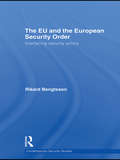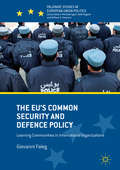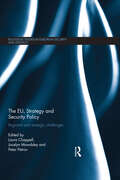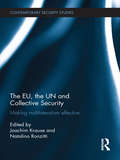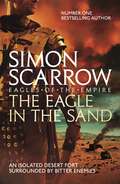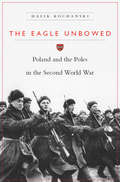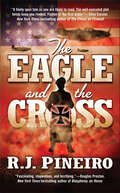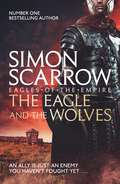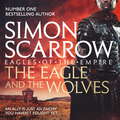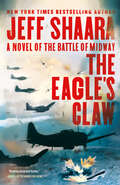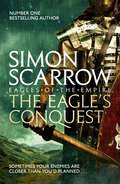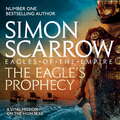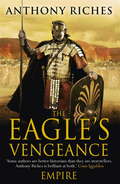- Table View
- List View
The EU and the European Security Order: Interfacing Security Actors (Contemporary Security Studies)
by Rikard BengtssonThis book attempts to conceptualise EU action in the field of regional security. Drawing on constructivist theory, the framework of the book focuses on the meeting - or 'interface' - of actors, a situation reflecting the mutual construction of self, other and situation. The analytical framework applied here to European security politics is potentially open-ended as the theoretical logic that informs the framework is general and abstract in character, and not limited to state actors in an international setting. The empirical aim of this book is to further our understanding of the EU as a security actor in a regional perspective. The book thus links International Relations scholarship with that of EU studies. By analyzing a number of different interfaces (such as with Russia, the US, and other states), we can learn more about the circumstances and preconditions and with what resources and power the EU acts in a regional security setting. This book will be of great interest to students of European security, EU policy, IR theory and security studies in general. Rikard Bengtsson is Assistant Professor of Political Science at Lund University, Sweden. He has a PhD in Political Science, from Lund University, Sweden.
The EU's Common Security and Defence Policy
by Giovanni FalegThis book accounts for transformations in the EU's Common Security and Defence Policy (CSDP)during fifteen years of operations (2001-2016), and argues that the EU evolved into a softer and more civilian security provider, rather than a military one. This learning process was driven by transnational communities of experts and practitioners, which acted as engines of change. Giovanni Faleg analyses two innovative concepts introduced in the EU security discourse since the late 1990s: security sector reform (SSR) and civilian crisis management (CCM). Both stem from a new understanding of security, involving the development of non-military approaches and a comprehensive approach to crisis management. However, the implementation of the two policy frameworks by the EU led to very different outcomes. The book explains this variation by exploring the pathways by which ideas turn into policies, and by comparing the transformational power of epistemic communities and communities of practice.
The EU, Strategy and Security Policy: Regional and Strategic Challenges (Routledge Studies in European Security and Strategy)
by Laura Chappell, Jocelyn Mawdsley and Petar PetrovThis edited collection is a timely and in-depth analysis of the EU’s efforts to bring coherency and strategy to its security policy actions. Despite a special European Council summit in December 2013 on defence, it is generally acknowledged that fifteen years since its inception the EU’s Common Security and Defence Policy (CSDP) has yet to acquire a clear sense of purpose. This book investigates those areas where the EU has established actorness in the security and defence field and asks whether they might constitute the elements of an emergent more coherent EU strategy on security. Taking a critical view, the contributors map the EU’s strategic vision(s) across particular key regions where the EU has been active as a security actor, the strategic challenges that it has pinpointed alongside the opportunities and barriers posed by a multiplicity of actors, interests and priorities identified by both member states and EU actors. By doing this we demonstrate where gaps in strategic thinking lie, where the EU has been unable to achieve its aims, and offer recommendations concerning the EU’s future strategic direction. This book will be of much interest to students of European security, EU policy, strategic studies and IR in general.
The EU, the UN and Collective Security: Making Multilateralism Effective (Contemporary Security Studies)
by Krause Joachim Ronzitti NatalinoThis book examines the effectiveness of multilateralism in ensuring collective security and, in particular, the EU’s role in this process. In 1992, shortly after the end of the Cold War, a Security Council Summit in New York reaffirmed the salience of the system of collective security and stated the determination of the Heads of State to maintain it as the prime international instrument for preserving peace. Twenty years later, however, the record of collective security as well as of multilateralism has not been very encouraging. The system of collective security, as enshrined in the United Nations (UN) Charter, failed repeatedly to accomplish its mandate in the 1990s and has led to controversial debates in the United States and Europe that reached a climax during the Iraq crisis in 2002/03. The volume draws upon both theoretical and empirical research to answer the following core questions: What are the reasons that have made multilateralism either effective or ineffective in the field of peacekeeping, peace preservation and peacebuilding? How can multilateralism be made more effective? How can attempts made by Europe to render UN multilateralism in the security area more efficient be assessed? This book will be of much interest to students of peacebuilding/peacekeeping, EU policy, the UN, security studies and IR in general.
The EU’s Strategic Dilemma in the Ukraine War: Sanctions, Military Aid, and the Struggle for Coherence in Foreign Policy (SpringerBriefs in International Relations)
by Viktor JakupecAs the war in Ukraine enters its fourth year, this book critically examines the strategies employed by the European Union (EU) and the United States (US) in their support of Ukraine. It examines how sanctions, military aid, and diplomacy have shaped the conflict and considers whether these efforts are falling short. Through political, economic, and strategic analysis, it explores the EU’s internal divisions, the changing role of US leadership under a second Trump administration, and the increasing risk of Ukraine being marginalised in global negotiations. The author questions whether the EU’s reliance on sanctions and fragmented military support has weakened its own position more than that of Russia. Providing a realist perspective on the war’s broader geopolitical consequences and the uncertain future of European security, this book challenges dominant narratives.
The Eagle In The Sand (Eagles of the Empire #7)
by Simon ScarrowIF YOU DON'T KNOW SIMON SCARROW, YOU DON'T KNOW ROME!THE EAGLE IN THE SAND is the action-packed seventh novel in Simon Scarrow's bestselling Eagles of the Empire series. Essential reading for fans of Bernard Cornwell. 'Scarrow's [novels] rank with the best' IndependentJudaea in AD 46. Roman centurions Cato and Macro have been posted to Judaea for a 'hearts and minds' operation. The Empire needs to win over the locals after some of their religious figures have started revolts - and since the Romans crucified the last charismatic Judaean leader, the natives' rebellions have become bolder.Not only are these small villages causing trouble, but there are also thousands of Parthians eager to fight Rome. With the threat of suicide attacks and even all-out war, Cato and Macro have their peace-keeping work cut out...
The Eagle In The Sand (Eagles of the Empire #7)
by Simon ScarrowIF YOU DON'T KNOW SIMON SCARROW, YOU DON'T KNOW ROME!THE EAGLE IN THE SAND is the action-packed seventh novel in Simon Scarrow's bestselling Eagles of the Empire series. Essential reading for fans of Bernard Cornwell. 'Scarrow's [novels] rank with the best' IndependentJudaea in AD 46. Roman centurions Cato and Macro have been posted to Judaea for a 'hearts and minds' operation. The Empire needs to win over the locals after some of their religious figures have started revolts - and since the Romans crucified the last charismatic Judaean leader, the natives' rebellions have become bolder.Not only are these small villages causing trouble, but there are also thousands of Parthians eager to fight Rome. With the threat of suicide attacks and even all-out war, Cato and Macro have their peace-keeping work cut out...
The Eagle In The Sand: Cato & Macro: Book 7 (Eagle #27)
by Simon ScarrowIF YOU DON'T KNOW SIMON SCARROW, YOU DON'T KNOW ROME!THE EAGLE IN THE SAND is the action-packed seventh novel in Simon Scarrow's bestselling Eagles of the Empire series. Essential reading for fans of Bernard Cornwell. 'Scarrow's [novels] rank with the best' IndependentJudaea in AD 46. Roman centurions Cato and Macro have been posted to Judaea for a 'hearts and minds' operation. The Empire needs to win over the locals after some of their religious figures have started revolts - and since the Romans crucified the last charismatic Judaean leader, the natives' rebellions have become bolder.Not only are these small villages causing trouble, but there are also thousands of Parthians eager to fight Rome. With the threat of suicide attacks and even all-out war, Cato and Macro have their peace-keeping work cut out...(P)2012 Headline Publishing Group Ltd
The Eagle Unbowed: Poland and the Poles in the Second World War
by Halik KochanskiWorld War II gripped Poland as it did no other country. Invaded by Germany and the USSR, it was occupied from the first day of war to the last, and then endured 44 years behind the Iron Curtain while its wartime partners celebrated their freedom. The Eagle Unbowed tells, for the first time, the story of Poland’s war in its entirety and complexity.
The Eagle and the Cross
by R. J. PineiroThe Bloodiest Battle in World HistoryAt Stalingrad 3.2 million men and women will die. Those fighting include:Captain Jack Towers of the US Army Air Corps—who will learn duty, courage and . . . love.Lieutenant Erich Steinhoff, the Luftwaffe ace—who will watch the city be blanketed by fire.Colonel Aleksandrovich Krasilov, the Red Air Force star—who will battle Goering's Luftwaffe while searching for his missing wife.Dr. Zoya Krasilov, the Colonel's wife—who, captured when her hospital is overrun, will escape a Nazi death camp to join the Resistance and become a Stalingrad sniper.Lieutenant Natalya Makarova, of USSR's Night Witches—who will fly night sorties over Germany in WWI biplanes . . . and vie for Jack Towers' love.At the Publisher's request, this title is being sold without Digital Rights Management Software (DRM) applied.
The Eagle and the Wolves (Eagles of the Empire #4)
by Simon ScarrowIF YOU DON'T KNOW SIMON SCARROW, YOU DON'T KNOW ROME!THE EAGLE AND THE WOLVES is the gripping fourth novel in Simon Scarrow's bestselling Eagles of the Empire series. Perfect for fans of Bernard Cornwell and Conn Iggulden. 'A new book in Simon Scarrow's long-running series about the Roman army is always a joy' The TimesBritannia, AD 44. Occupation is never easy. The enemy is butchering their supply convoys, their garrison town is starving and the truce with the locals is uneasy at best. Young Cato, newly promoted, and veteran centurion Macro are ordered to train the Wolves and the Boars, two cohorts of barbarian Britons, and introduce them to the brutal drills of the Roman Imperial Army. Macro is confident they'll win the natives over, but Cato worries about putting weapons into the hands of potential rebels.Ultimately, only one thing matters: is there a difference between the enemy at their gates, and the allies in their own camp?
The Eagle and the Wolves (Eagles of the Empire #4)
by Simon ScarrowIF YOU DON'T KNOW SIMON SCARROW, YOU DON'T KNOW ROME!THE EAGLE AND THE WOLVES is the gripping fourth novel in Simon Scarrow's bestselling Eagles of the Empire series. Perfect for fans of Bernard Cornwell and Conn Iggulden. 'A new book in Simon Scarrow's long-running series about the Roman army is always a joy' The TimesBritannia, AD 44. Occupation is never easy. The enemy is butchering their supply convoys, their garrison town is starving and the truce with the locals is uneasy at best. Young Cato, newly promoted, and veteran centurion Macro are ordered to train the Wolves and the Boars, two cohorts of barbarian Britons, and introduce them to the brutal drills of the Roman Imperial Army. Macro is confident they'll win the natives over, but Cato worries about putting weapons into the hands of potential rebels.Ultimately, only one thing matters: is there a difference between the enemy at their gates, and the allies in their own camp?
The Eagle and the Wolves: Cato & Macro: Book 4 (Eagle #21)
by Simon ScarrowIF YOU DON'T KNOW SIMON SCARROW, YOU DON'T KNOW ROME!THE EAGLE AND THE WOLVES is the gripping fourth novel in Simon Scarrow's bestselling Eagles of the Empire series. Perfect for fans of Bernard Cornwell and Conn Iggulden. 'A new book in Simon Scarrow's long-running series about the Roman army is always a joy' The TimesBritannia, AD 44. Occupation is never easy. The enemy is butchering their supply convoys, their garrison town is starving and the truce with the locals is uneasy at best. Young Cato, newly promoted, and veteran centurion Macro are ordered to train the Wolves and the Boars, two cohorts of barbarian Britons, and introduce them to the brutal drills of the Roman Imperial Army. Macro is confident they'll win the natives over, but Cato worries about putting weapons into the hands of potential rebels.Ultimately, only one thing matters: is there a difference between the enemy at their gates, and the allies in their own camp?(P)2017 Headline Publishing Group Ltd.
The Eagle in the Mirror
by Jesse FinkPart biography, part forensic jigsaw puzzle, part cold-case detective investigation, The Eagle in the Mirror is the astonishing untold story of Charles Howard &“Dick&” Ellis, the Australian-born British intelligence officer and master spy accused by some espionage experts of being the traitor of the century. The longest serving spy for the Secret Intelligence Service (MI6), Ellis came to New York at the beginning of World War II as deputy to William Stephenson at British Security Coordination (BSC) and helped set up for William Donovan the Office of Strategic Services (OSS), what would eventually evolve into the Central Intelligence Agency (CIA). At one point in the 1940s he was considered one of the top three secret agents in MI6, controlling its activities &“for half the world.&” Ellis allegedly received prior warning of the Japanese attack on Pearl Harbor and, through the conduit of Stephenson, relayed that warning to President Franklin D. Roosevelt. After World War II, Ellis was awarded the Legion of Merit by President Harry S. Truman. But in the 1980s espionage writer Chapman Pincher and retired Security Service (MI5) intelligence officer Peter Wright posthumously accused Ellis of having operated as a &“triple agent&” for Nazi Germany and the Soviet Union. In 1965, while under interrogation in London, Ellis had allegedly made a confession that he had supplied information to the Nazis prior to the war. The scope of Ellis&’s purported betrayal was considered even worse than notorious British traitor and double agent Kim Philby, who defected to the Soviet Union in 1963. However, Pincher&’s and Wright&’s accusations against Ellis have never been comprehensively proven. Was Ellis guilty or was an innocent man framed? Did he take the fall for someone else? Or had the intelligence agencies of the United States, the United Kingdom and Australia been fatally compromised by a &“super-mole&”? Jesse Fink unravels a gripping real-life international whodunit in this long-overdue biography of the unheralded Dick Ellis, one of the most consequential figures in modern history.
The Eagle's Claw: A Novel of the Battle of Midway
by Jeff ShaaraIn a riveting tale that picks up where To Wake the Giant left off, New York Times bestselling author Jeff Shaara transports us to the Battle of Midway in another masterpiece of military historical fiction.Spring 1942. The United States is reeling from the blow the Japanese inflicted at Pearl Harbor. But the Americans are determined to turn the tide. The key comes from Commander Joe Rochefort, a little known &“code breaker&” who cracks the Japanese military encryption. With Rochefort&’s astonishing discovery, Admiral Chester Nimitz will know precisely what the Japanese are planning.But the battle to counter those plans must still be fought.From the American side, the shocking conflict is seen through the eyes of Rochefort and Admiral Nimitz, as well as fighter pilot Lieutenant Percy &“Perk&” Baker and Marine Gunnery Sergeant Doug Ackroyd.On the Japanese side, Admiral Isoroku Yamamoto is the mastermind. His key subordinates are Admiral Chuichi Nagumo, aging and infirm, and Admiral Tamon Yamaguchi, a firebrand who has no patience for Nagumo&’s hesitation. Together, these two men must play out the chess game designed by Yamamoto, without any idea that the Americans are anticipating their every move on the sea and in the air.Jeff Shaara recounts in electrifying detail what happens when these two sides finally meet, in what will be known ever after as one of the most definitive and heroicexamples of combat ever seen. In The Eagle&’s Claw, he recounts, with his trademark you-are-there immediacy and signature depth of research, one single battle that changed not only the outcome of a war but the course of our entire global history.The story of Midway has been told many times, but never before like this.
The Eagle's Conquest (Eagles of the Empire #2)
by Simon ScarrowIF YOU DON'T KNOW SIMON SCARROW, YOU DON'T KNOW ROME!THE EAGLE'S CONQUEST is the thrilling second novel in Simon Scarrow's bestselling Eagles of the Empire series. Essential reading for fans of Bernard Cornwell and Conn Iggulden. Praise for Simon Scarrow's compelling historical novels: 'Gripping and moving' The TimesBritannia, AD 43. Bleak, rainy and full of vicious savages, Britannia is a land that Cato, solider of the Second Legion, wishes Rome didn't want to conquer. And as right-hand man to Centurion Macro, Cato sees the very worst of his native Britons, battling alongside his commander in bloodier combat than he could ever have imagined.But the Britons are fighting back with Roman weapons - which means someone in their own ranks is supplying arms to the enemy. Cato and Macro are about to discover even deadlier adversaries than the British barbarians...
The Eagle's Conquest (Eagles of the Empire #2)
by Simon ScarrowIF YOU DON'T KNOW SIMON SCARROW, YOU DON'T KNOW ROME!THE EAGLE'S CONQUEST is the thrilling second novel in Simon Scarrow's bestselling Eagles of the Empire series. Essential reading for fans of Bernard Cornwell and Conn Iggulden. Praise for Simon Scarrow's compelling historical novels: 'Gripping and moving' The TimesBritannia, AD 43. Bleak, rainy and full of vicious savages, Britannia is a land that Cato, solider of the Second Legion, wishes Rome didn't want to conquer. And as right-hand man to Centurion Macro, Cato sees the very worst of his native Britons, battling alongside his commander in bloodier combat than he could ever have imagined.But the Britons are fighting back with Roman weapons - which means someone in their own ranks is supplying arms to the enemy. Cato and Macro are about to discover even deadlier adversaries than the British barbarians...
The Eagle's Conquest: Cato & Macro: Book 2 (Eagle #9)
by Simon ScarrowTHE EAGLE'S CONQUEST is the thrilling second novel in Simon Scarrow's bestselling Eagles of the Empire series. Essential reading for fans of Bernard Cornwell and Conn Iggulden.When Centurion Macro arrives on British soil as one of Emperor Claudius's invasion force in AD 43, he is facing one of the toughest campaigns of his battle-scarred career. In a series of bloody skirmishes, Macro and his young subordinate, Optio Cato, and the desperately outnumbered Roman army must find and defeat the enemy before he grows strong enough to overwhelm the legions. But the Britons are not the only foe facing Macro and Cato. A sinister organisation opposed to the Emperor is secretly betraying the invaders. And when rumours of an assassination attempt coincide with the Emperor's arrival on British soil, the soldiers realise they are up against a force more ruthless than their acknowledged enemy...
The Eagle's Prey (Eagles of the Empire #29)
by Simon ScarrowIF YOU DON'T KNOW SIMON SCARROW, YOU DON'T KNOW ROME!THE EAGLE'S PREY is the thrilling fifth novel in Simon Scarrow's bestselling Eagles of the Empire series. A must read for fans of Bernard Cornwell and Conn Iggulden. Praise for Simon Scarrow's gripping historical novels: 'Ferocious and compelling' Daily ExpressBritannia, AD 44. The time has come to claim Britain for the Empire. Centurions Cato and Macro are preparing for what their leaders say will be the final battle against those natives refusing to accept the civilising force of Rome. The British savages will surely stand no chance against the might of the unstoppable Roman army.But young Cato is more concerned about hot-headed cohort commander, Maximius, than about the enemy, and with Roman troops being brutally slaughtered, even grizzled veteran Macro is having doubts about the promised ease of their success. Will they be victorious - or will the battle cost both of them more than they could ever imagine?
The Eagle's Prey (Eagles of the Empire 5)
by Simon ScarrowIF YOU DON'T KNOW SIMON SCARROW, YOU DON'T KNOW ROME!THE EAGLE'S PREY is the thrilling fifth novel in Simon Scarrow's bestselling Eagles of the Empire series. A must read for fans of Bernard Cornwell and Conn Iggulden. Praise for Simon Scarrow's gripping historical novels: 'Ferocious and compelling' Daily ExpressBritannia, AD 44. The time has come to claim Britain for the Empire. Centurions Cato and Macro are preparing for what their leaders say will be the final battle against those natives refusing to accept the civilising force of Rome. The British savages will surely stand no chance against the might of the unstoppable Roman army.But young Cato is more concerned about hot-headed cohort commander, Maximius, than about the enemy, and with Roman troops being brutally slaughtered, even grizzled veteran Macro is having doubts about the promised ease of their success. Will they be victorious - or will the battle cost both of them more than they could ever imagine?
The Eagle's Prey: Cato & Macro: Book 5 (Eagle #25)
by Simon ScarrowTHE EAGLE'S PREY is the thrilling fifth novel in Simon Scarrow's bestselling Eagles of the Empire series. A must read for fans of Bernard Cornwell and Conn Iggulden.It is late summer 44 AD and the battle-weary Roman legions are in their second year of campaigning against the British tribes. The troops' commander, General Plautius, is under pressure from the Emperor to crush the natives once and for all. Centurions Macro and Cato are with the crack Second Legion under the precarious leadership of Centurion Maximus and it's their task to hold a ford across the river Tamesis when the natives are forced into a trap. But Maximus's nerve breaks at the critical point, allowing the enemy leader, Caratacus, and his men to escape.Outraged by this failure, General Plautius orders the decimation of the unit. Their choice: die, or escape to become a fugitive pursued by soldiers of their own ruthless army. Hiding from their former comrades, as well as the Britons, Cato's small band of fugitives have only one chance to redeem themselves before they are hunted down like animals...(P)2017 Headline Publishing Group Limited
The Eagle's Prophecy (Eagles of the Empire #30)
by Simon ScarrowIF YOU DON'T KNOW SIMON SCARROW, YOU DON'T KNOW ROME!THE EAGLE'S PROPHECY is the powerful sixth novel in Simon Scarrow's bestselling Eagles of the Empire seires. Perfect for fans of Bernard Cornwell. Praise for Simon Scarrow's gripping novels: 'Ferocious and compelling' Daily Express The Adriatic Sea, AD 45. Cato and Macro, centurions of the Roman army, are horrified to learn that they face possible execution after the death of their commanding officer. Fortunately, the Emperor's secretary is willing to offer them an alternative: to join the marines and hunt down a band of brutal pirates who are decimating not only Rome's reputation, but also a critical supply chain.As they discover the true horror of battle at sea, Macro and Cato must also remember their real mission: to recover from those pirates a set of scrolls that hold secrets vital to the future of the Roman Empire. Rome will do anything to get them back...
The Eagle's Prophecy (Eagles of the Empire 6)
by Simon ScarrowIF YOU DON'T KNOW SIMON SCARROW, YOU DON'T KNOW ROME!THE EAGLE'S PROPHECY is the powerful sixth novel in Simon Scarrow's bestselling Eagles of the Empire seires. Perfect for fans of Bernard Cornwell. Praise for Simon Scarrow's gripping novels: 'Ferocious and compelling' Daily Express The Adriatic Sea, AD 45. Cato and Macro, centurions of the Roman army, are horrified to learn that they face possible execution after the death of their commanding officer. Fortunately, the Emperor's secretary is willing to offer them an alternative: to join the marines and hunt down a band of brutal pirates who are decimating not only Rome's reputation, but also a critical supply chain.As they discover the true horror of battle at sea, Macro and Cato must also remember their real mission: to recover from those pirates a set of scrolls that hold secrets vital to the future of the Roman Empire. Rome will do anything to get them back...
The Eagle's Prophecy: Cato & Macro: Book 6 (Cato & Macro #6)
by Simon ScarrowIF YOU DON'T KNOW SIMON SCARROW, YOU DON'T KNOW ROME!THE EAGLE'S PROPHECY is the powerful sixth novel in Simon Scarrow's bestselling Eagles of the Empire seires. Perfect for fans of Bernard Cornwell. Praise for Simon Scarrow's gripping novels: 'Ferocious and compelling' Daily Express The Adriatic Sea, AD 45. Cato and Macro, centurions of the Roman army, are horrified to learn that they face possible execution after the death of their commanding officer. Fortunately, the Emperor's secretary is willing to offer them an alternative: to join the marines and hunt down a band of brutal pirates who are decimating not only Rome's reputation, but also a critical supply chain.As they discover the true horror of battle at sea, Macro and Cato must also remember their real mission: to recover from those pirates a set of scrolls that hold secrets vital to the future of the Roman Empire. Rome will do anything to get them back...(P)2012 Headline Publishing Group Ltd
The Eagle's Vengeance: Empire VI (Empire Ser. #6)
by Anthony Riches'A master of the genre' The TimesThe Tungrian auxiliary cohorts return to Hadrian's Wall after their successful Dacian campaign, only to find Britannia in chaos. The legions are overstretched, struggling to man the forts of the northern frontier in the face of increasing barbarian resistance. The Tungrians are the only soldiers who can be sent into the northern wastes, far beyond the long abandoned wall built by Antoninus, where a lost symbol of imperial power of the Sixth Victorious Legion is reputed to await them. Protected by an impassable swamp and hidden in a fortress atop a high mountain, the eagle of the Sixth legion must be recovered if the legion is to survive. Marcus and his men must penetrate the heart of the enemy's strength, ghosting through a deadly wilderness patrolled by vicious huntresses before breaching the walls of the Fang, an all-but-impregnable fort, if they are to rescue the legion's venerated standard. If successful their escape will be twice as perilous, with the might of a barbarian tribe at their heels.
